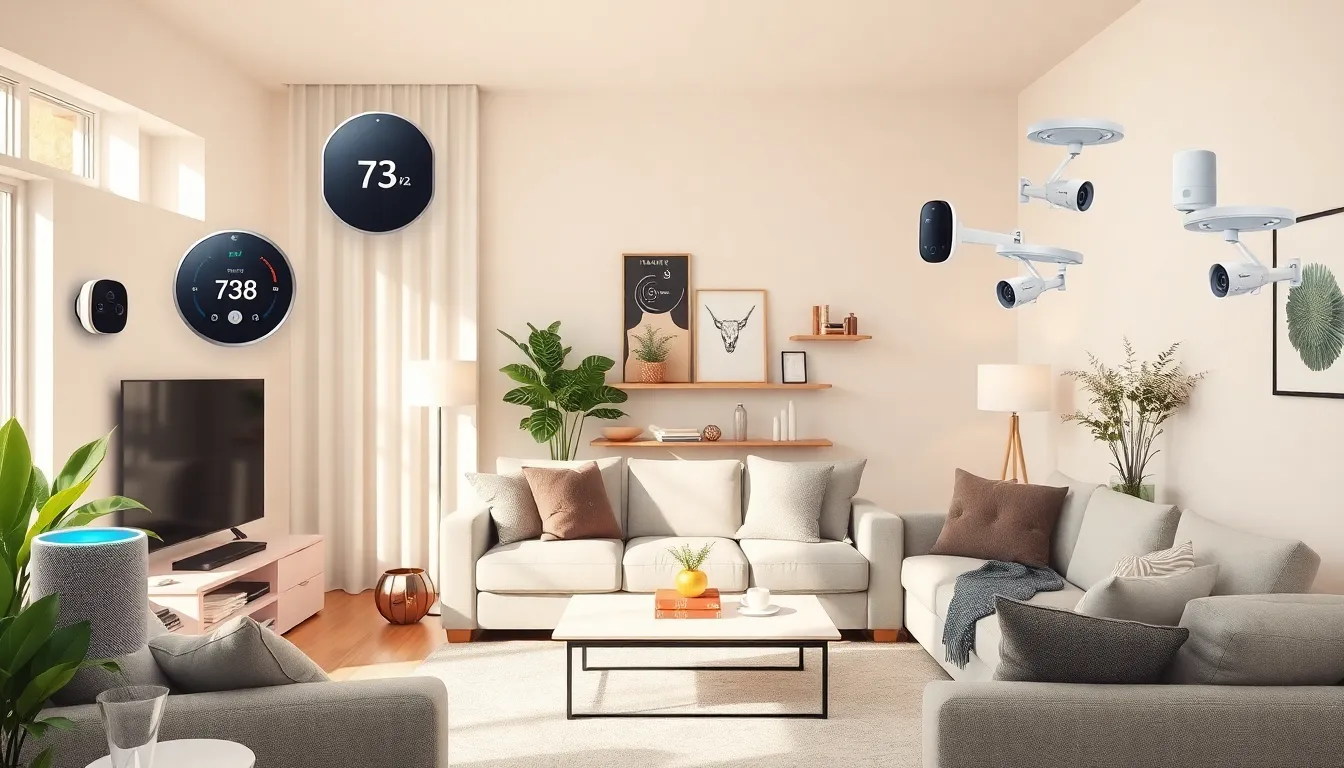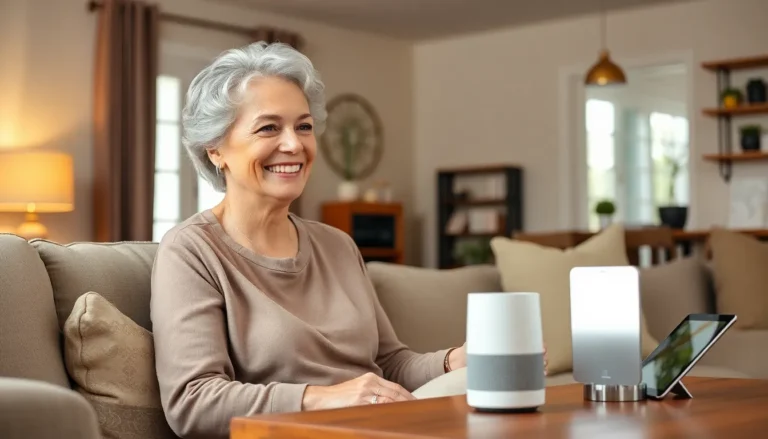Table of Contents
ToggleIn a world where your coffee maker can brew a fresh cup while you’re still dreaming of unicorns, smart home devices are the new superheroes of modern living. They promise convenience, security, and the ability to control your home with just a tap on your phone. But before you can kick back and let technology do the heavy lifting, there’s the small matter of installation.
Overview of Smart Home Devices Installation
Smart home device installation encompasses several key steps that ensure optimal functionality and user experience. First, users must determine their specific needs, as this influences the choice of devices. Installing security cameras requires different considerations than smart thermostats or lighting systems.
Next, compatibility plays a crucial role in the installation process. Devices must integrate seamlessly with existing home networks and other smart home components. Researching compatible ecosystems, such as Google Home or Amazon Alexa, simplifies the selection.
Setting up is often straightforward, with most manufacturers providing detailed instructions. Users can usually complete the initial setup within 30 minutes. Connecting devices to the home’s Wi-Fi network is a common step, which generally involves entering the network password within the accompanying mobile application.
After establishing a connection, configuring settings according to personal preferences enhances usability. Adjustments may include scheduling, automation routines, and voice commands. Familiarizing oneself with the app interface offers better control over the smart home environment.
Troubleshooting may arise during installation, making it essential for users to refer to online resources or customer support. Common issues may include connectivity errors or malfunctioning devices. Many manufacturers provide dedicated support teams to assist users as they navigate these challenges.
Finally, ongoing maintenance ensures smart devices function effectively over time. Software updates enhance security and introduce new features, helping users maximize their investment. By staying informed about these developments, users maintain a connected and secure smart home environment.
Benefits of Smart Home Devices

Smart home devices offer numerous benefits that transform daily living into a more efficient experience. The convenience and security they provide lead to a significant improvement in lifestyle quality.
Increased Convenience
Smart home devices simplify everyday tasks through automation. Users can control lights, thermostats, and appliances remotely using mobile apps. This capability eliminates the need for manual operation. Voice commands via devices like Google Home or Amazon Alexa enhance control even further. Managing home settings adjusts to personal routines, providing a seamless experience. Scheduling tasks like turning on lights during specific times boosts efficiency. Moreover, monitoring energy usage leads to better consumption habits. Devices connected to a smart hub communicate consistently, ensuring convenience across the home. Convenience translates into a more organized, manageable lifestyle.
Enhanced Security
Smart home devices significantly improve security measures at home. Surveillance cameras provide real-time monitoring, allowing users to check their property remotely. Motion detectors trigger alerts when unexpected movement occurs, keeping users informed. Doorbell cameras enable visual confirmation of visitors before granting access. Additionally, smart locks can be controlled with a smartphone, eliminating the need for traditional keys. These advanced features allow users to manage access easily, providing peace of mind. Security systems can also be integrated with emergency services for rapid responses. Regular software updates maintain device security and functionality, ensuring ongoing protection at home. Enhanced security fosters a sense of safety, essential for any living environment.
Types of Smart Home Devices
Smart home devices fall into various categories, each offering unique functionalities that enhance everyday living. Understanding these types helps consumers choose the best options for their needs.
Smart Lighting
Smart lighting systems allow users to control brightness and color through mobile applications or voice commands. Bulbs can be set on schedules, enabling automation for energy savings. Features like dimming or scene settings enhance ambiance for different activities, such as movie nights or hosting gatherings. Brands like Philips Hue and LIFX provide options that fit standard sockets, ensuring easy installation. Users can also group lights and control them simultaneously, simplifying the management of multiple fixtures.
Smart Thermostats
Smart thermostats optimize energy use by learning the user’s schedule and preferences. Devices like the Nest Learning Thermostat adjust temperatures automatically, promoting comfort and efficiency. Remote access via apps allows temperature changes from anywhere, whether at home or away. Some models offer energy usage reports, helping homeowners track and reduce utility costs. By integrating with existing heating and cooling systems, they provide an eco-friendly option that enhances overall home climate control.
Smart Security Cameras
Smart security cameras offer real-time monitoring and recording capabilities, enhancing home security. Users can receive alerts for motion detection, ensuring awareness of any unusual activity. High-definition video quality allows for clear surveillance, while features like night vision ensure visibility in low-light conditions. Options like the Ring and Arlo cameras provide cloud storage solutions for recorded footage, allowing users to review past events. Integration with other smart devices, such as smart locks, creates a comprehensive security ecosystem.
Preparing for Installation
Familiarity with the installation process enhances the experience of using smart home devices. Key steps focus on assessing compatibility and selecting the right devices.
Assessing Home Compatibility
Compatibility plays a vital role in the seamless operation of smart home devices. Start by evaluating the existing home network and ensure a reliable Wi-Fi connection is available in all areas where devices will be installed. Identify platforms like Google Home or Amazon Alexa to confirm integration capabilities. Users should consider the specific requirements of their devices, as not all units work with every ecosystem. Many smart devices offer compatibility lists on their packaging or websites, making it easier to pair devices with current systems. This assessment prevents frustration during installation and guarantees smoother functionalities once everything is set up.
Choosing the Right Devices
Selecting suitable devices aligns closely with the individual needs of users. Determine which features bring the most value, such as security, convenience, or energy efficiency. Smart lighting systems, thermostats, and security cameras each serve distinct purposes, so prioritization is key. Users benefit from creating a list of desired functionalities and comparing them against available options. Researching well-known brands, like Philips Hue for lighting or Nest for thermostats, helps streamline the decision-making process. Take time to read reviews and examine integration capabilities before settling on a choice. Such diligence ensures selected devices enhance the overall smart home experience.
Step-by-Step Installation Process
Installing smart home devices involves several straightforward steps. Understanding this process ensures successful integration into any living space.
Tools You Will Need
Gather essential tools before starting the installation process. A screwdriver, an electric drill, and a level are often necessary for mounting devices. Some devices may require specific tools included in their packaging. Access to a smartphone or tablet is crucial for connecting to the device’s app. The right equipment simplifies installation, ensuring everything fits properly.
Installation Guide for Different Devices
Follow specific installation instructions for each type of smart home device. For smart lighting systems, replace existing bulbs with smart ones, then connect them to the app for configuration. Smart thermostats typically involve removing the old thermostat, wiring the new unit based on provided guidelines, and syncing it with Wi-Fi. When dealing with security cameras, mount them in strategic locations, ensure a stable connection, and set them up through the associated app. Orientation and installation steps differ slightly, making it vital to consult the user manual or online resources for optimal outcomes.
Embracing smart home devices can significantly enhance daily living by providing convenience and security. With a clear understanding of the installation process and the right preparation, users can seamlessly integrate these technologies into their homes.
By selecting compatible devices and utilizing available resources for installation and troubleshooting, individuals can create an efficient and secure living environment. Ongoing maintenance and updates are vital for optimal performance, ensuring that these devices continue to meet evolving needs.
As smart technology continues to advance, staying informed will empower users to make the most of their smart home experience.




